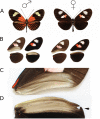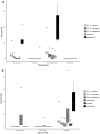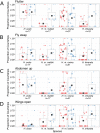Male sex pheromone components in Heliconius butterflies released by the androconia affect female choice - PubMed (original) (raw)
Male sex pheromone components in Heliconius butterflies released by the androconia affect female choice
Kathy Darragh et al. PeerJ. 2017.
Abstract
Sex-specific pheromones are known to play an important role in butterfly courtship, and may influence both individual reproductive success and reproductive isolation between species. Extensive ecological, behavioural and genetic studies of Heliconius butterflies have made a substantial contribution to our understanding of speciation. Male pheromones, although long suspected to play an important role, have received relatively little attention in this genus. Here, we combine morphological, chemical and behavioural analyses of male pheromones in the Neotropical butterfly Heliconius melpomene. First, we identify putative androconia that are specialized brush-like scales that lie within the shiny grey region of the male hindwing. We then describe putative male sex pheromone compounds, which are largely confined to the androconial region of the hindwing of mature males, but are absent in immature males and females. Finally, behavioural choice experiments reveal that females of H. melpomene, H. erato and H. timareta strongly discriminate against conspecific males which have their androconial region experimentally blocked. As well as demonstrating the importance of chemical signalling for female mate choice in Heliconius butterflies, the results describe structures involved in release of the pheromone and a list of potential male sex pheromone compounds.
Keywords: Androconia; Heliconius; Lepidoptera; Mate choice; Pheromone; Reproductive isolation; Sexual selection.
Conflict of interest statement
The authors declare there are no competing interests.
Figures
Figure 1. Heliconius melpomene wings showing androconial dimorphism.
(A) H. melpomene malleti (Ecuador sample, left) and H. melpomene plesseni (Ecuador sample, right). (B) Dissected wings from specimens of H. melpomene plesseni showing sexual dimorphism in the androconial region, with male (left) and female (right). For each sex, the left set of wings shows the ventral surface and the right set the dorsal surface. (C) Expanded view of the male forewing overlapping region. The pale grey-brown region was dissected for chemical analysis. (D) Expanded view of the male hindwing androconial region, with arrow highlight the vein Sc + R1. The pale grey-brown region was dissected for chemical analysis. The ventral side of the forewing is on the top and the dorsal side of the hindwing is on the bottom. The pale grey-brown region in the male wing was dissected for chemical analysis.
Figure 2. SEM images of scales from overlap regions of H. melpomene wings.
(A) Male hindwing; (B) male forewing and; (C) female hindwing at 500× magnification. (D) Magnified view of brush-like structures of the special scales in the male hindwing androconial region. Scale bars indicate 50 µm (A–C) and 2 µm (D).
Figure 3. SEM images of scales from hindwing overlap region in female and male H. melpomene.
(A) Scale from wing-overlap region of female. (B) Scale from androconial region of male with brush-like structures; the arrow highlights the bulge in the scale base in this region. Scale bars indicate 10 µm.
Figure 4. Regional differences in male androconial extracts.
Total ion chromatogram of extract from the androconial region of (A) a Panamanian H. melpomene rosina hindwing and (B) an Ecuadorian H. melpomene hindwing. 1, syringaldehyde; 2, (Z)-9-octadecenal; 3, octadecanal; 4, methyloctadecanals; 5, 1-octadecanol; 6, henicosane; 7, methyloctadecan-1-ols and nonadecanal; 8, (Z)-11-icosenal; 9, icosanal; 10, (Z)-11- icosenol; 11, tricosane; 12, (Z)-13-docosenal. All peaks eluting later than 44 min are cuticular compounds consisting of larger _n_-alkanes, 2,5-dialkyltetrahydrofurans, cholesterol or are contaminations. IS, internal standard.
Figure 5. Compounds detected by GC/MS of H. melpomene (Ecuador samples) wing extracts.
(A) Presence of compounds in different wing regions of five males (10 days post-eclosion). (B) Presence of compounds in five females (10 days post-eclosion), five young males (0 days post-eclosion) and five old males (10 days post-eclosion).
Figure 6. Proportion of courtships which resulted in different female behavioural responses.
Control males are represented in red (left) and experimental males in blue (right). Means are marked with a black square and boxplots mark the inter-quartile ranges. Size of datapoint is proportional to the number of courtships by that male. Female behavioural responses (A) Flutter; (B) Fly away; (C) Abdomen up; (D) Wings open.
Similar articles
- A major locus controls a biologically active pheromone component in Heliconius melpomene.
Byers KJRP, Darragh K, Musgrove J, Almeida DA, Garza SF, Warren IA, Rastas PM, Kučka M, Chan YF, Merrill RM, Schulz S, McMillan WO, Jiggins CD. Byers KJRP, et al. Evolution. 2020 Feb;74(2):349-364. doi: 10.1111/evo.13922. Epub 2020 Jan 20. Evolution. 2020. PMID: 31913497 Free PMC article. - Clustering of loci controlling species differences in male chemical bouquets of sympatric Heliconius butterflies.
Byers KJRP, Darragh K, Fernanda Garza S, Abondano Almeida D, Warren IA, Rastas PMA, Merrill RM, Schulz S, McMillan WO, Jiggins CD. Byers KJRP, et al. Ecol Evol. 2020 Dec 16;11(1):89-107. doi: 10.1002/ece3.6947. eCollection 2021 Jan. Ecol Evol. 2020. PMID: 33437416 Free PMC article. - Head and Tail Oxidized Terpenoid Esters from Androconia of Heliconius erato Butterflies.
Szczerbowski D, Ehlers S, Darragh K, Jiggins C, Schulz S. Szczerbowski D, et al. J Nat Prod. 2022 May 27;85(5):1428-1435. doi: 10.1021/acs.jnatprod.2c00300. Epub 2022 May 19. J Nat Prod. 2022. PMID: 35587731 Review. - Spider sex pheromones: emission, reception, structures, and functions.
Gaskett AC. Gaskett AC. Biol Rev Camb Philos Soc. 2007 Feb;82(1):27-48. doi: 10.1111/j.1469-185X.2006.00002.x. Biol Rev Camb Philos Soc. 2007. PMID: 17313523 Review.
Cited by
- A major locus controls a biologically active pheromone component in Heliconius melpomene.
Byers KJRP, Darragh K, Musgrove J, Almeida DA, Garza SF, Warren IA, Rastas PM, Kučka M, Chan YF, Merrill RM, Schulz S, McMillan WO, Jiggins CD. Byers KJRP, et al. Evolution. 2020 Feb;74(2):349-364. doi: 10.1111/evo.13922. Epub 2020 Jan 20. Evolution. 2020. PMID: 31913497 Free PMC article. - Identification and Composition of Clasper Scent Gland Components of the Butterfly Heliconius erato and Its Relation to Mimicry.
Ehlers S, Szczerbowski D, Harig T, Stell M, Hötling S, Darragh K, Jiggins CD, Schulz S. Ehlers S, et al. Chembiochem. 2021 Dec 2;22(23):3300-3313. doi: 10.1002/cbic.202100372. Epub 2021 Oct 8. Chembiochem. 2021. PMID: 34547164 Free PMC article. - Clustering of loci controlling species differences in male chemical bouquets of sympatric Heliconius butterflies.
Byers KJRP, Darragh K, Fernanda Garza S, Abondano Almeida D, Warren IA, Rastas PMA, Merrill RM, Schulz S, McMillan WO, Jiggins CD. Byers KJRP, et al. Ecol Evol. 2020 Dec 16;11(1):89-107. doi: 10.1002/ece3.6947. eCollection 2021 Jan. Ecol Evol. 2020. PMID: 33437416 Free PMC article. - Widespread Gene Expression Divergence in Butterfly Sensory Tissues Plays a Fundamental Role During Reproductive Isolation and Speciation.
Wu N, Evans E, van Schooten B, Meléndez-Rosa J, Ortiz Y, Planas Soto-Navarro SM, Van Belleghem SM, Counterman BA, Papa R, Zhang W. Wu N, et al. Mol Biol Evol. 2022 Nov 3;39(11):msac225. doi: 10.1093/molbev/msac225. Mol Biol Evol. 2022. PMID: 36251882 Free PMC article. - Manipulation of natal host modifies adult reproductive behaviour in the butterfly Heliconius charithonia.
Kemp DJ. Kemp DJ. Proc Biol Sci. 2019 Sep 11;286(1910):20191225. doi: 10.1098/rspb.2019.1225. Epub 2019 Sep 11. Proc Biol Sci. 2019. PMID: 31506053 Free PMC article.
References
- Ando T, Inomata S, Yamamoto M. Lepidopteran sex pheromones. In: Schulz S, editor. The chemistry of pheromones and other semiochemicals I. Springer; Berlin Heidelberg: 2004. pp. 51–96. (Topics in current chemistry). - PubMed
- Bacquet PMB, Brattström O, Wang H-L, Allen CE, Löfstedt C, Brakefield PM, Nieberding CM. Selection on male sex pheromone composition contributes to butterfly reproductive isolation. Proceedings of the Royal Society B: Biological Sciences. 2015;282 doi: 10.1098/rspb.2014.2734. Article 20142734. - DOI - PMC - PubMed
- Barth R. Os órgãos odoriferos masculinos de alguns Heliconiinae do Brasil. Memórias do Instituto Oswaldo Cruz. 1952;50:355–367.
- Bates HW. Contributions to an insect fauna of the Amazon valley. Lepidoptera: Heliconidae. Transactions of the Linnean Society of London. 1862;23:495–566. doi: 10.1111/j.1095-8312.1981.tb018S2.x. - DOI
- Becker HG, Beckert R. Organikum-organisch-chemisches praktikum. Wiley-VCH; Weinheim: 1993.
LinkOut - more resources
Full Text Sources
Other Literature Sources
Research Materials





